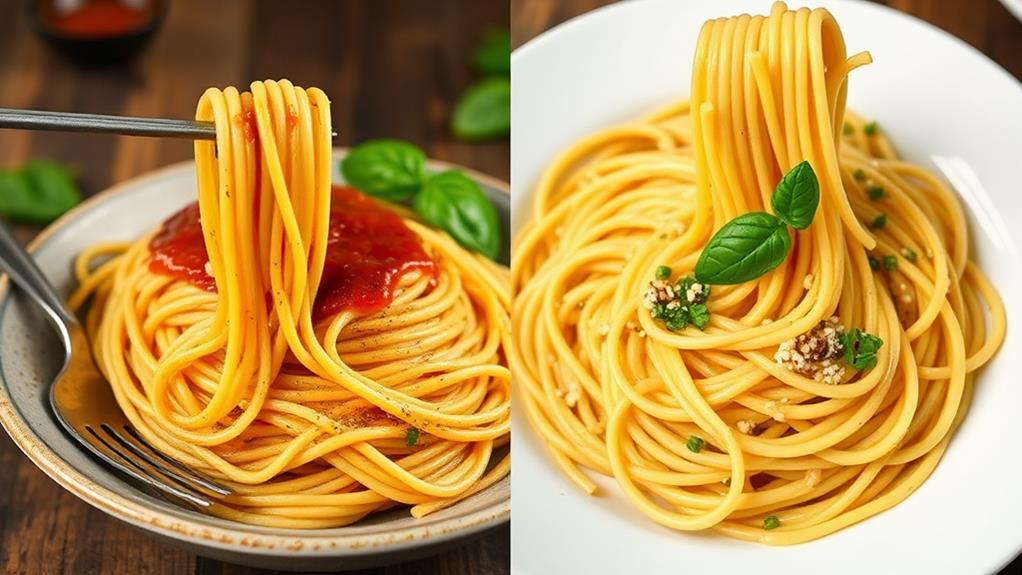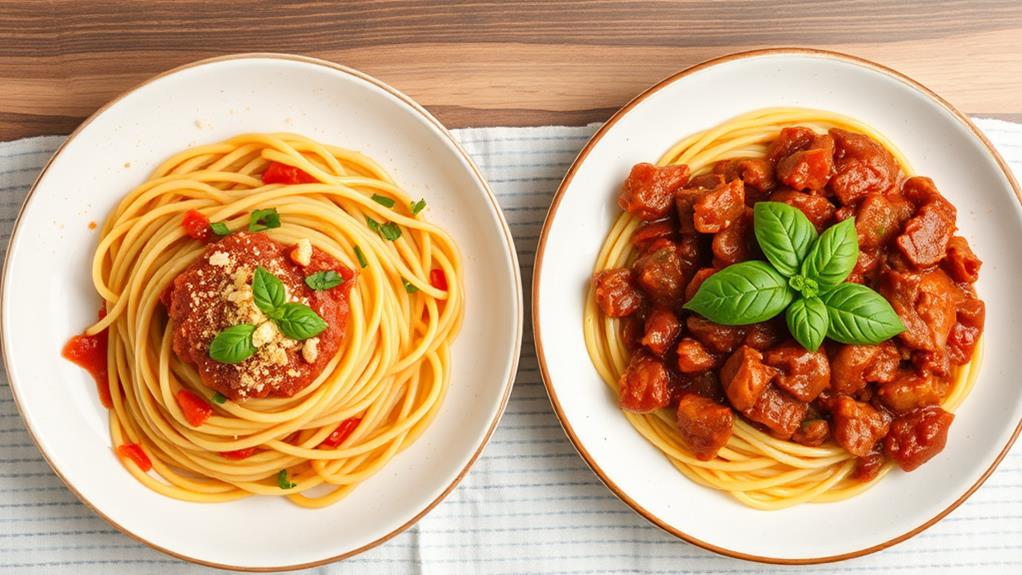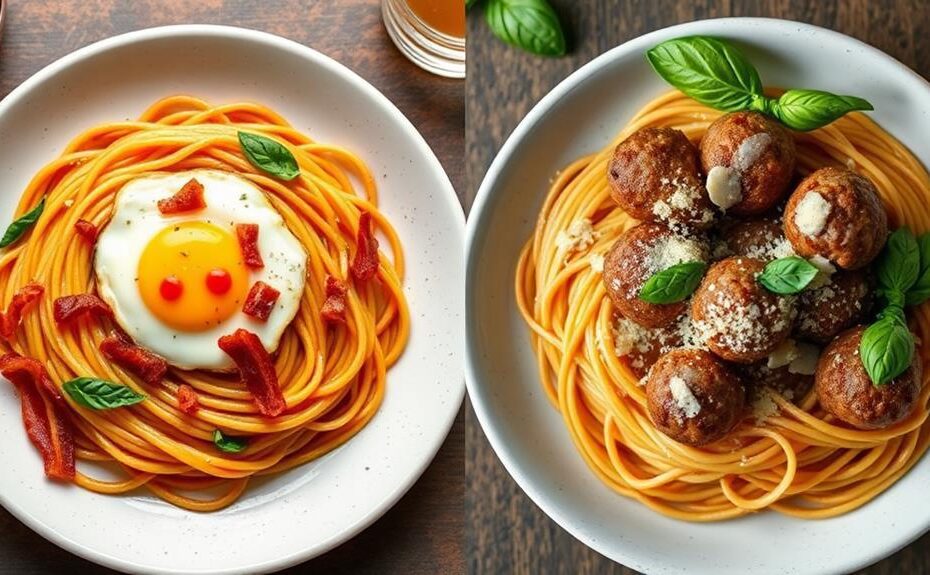Spaghetti Pinoy Style and traditional Italian Spaghetti have distinct differences in ingredients, flavors, and cultural significance.
One of the main differences is the use of ingredients. Filipino spaghetti incorporates banana ketchup, ground meat, and bright red hot dogs, giving it a sweeter and richer flavor profile.
In contrast, traditional Italian spaghetti relies on fresh tomatoes and herbs, resulting in a more savory flavor.
Another difference is the thickness and creaminess of the sauce. Filipino spaghetti uses native ingredients and cooking techniques, resulting in a thicker, creamier sauce.
Italian spaghetti, on the other hand, has a lighter, more brothy sauce.
The evolution of Filipino spaghetti is a fascinating story that highlights the cultural significance of this dish.
Filipino spaghetti has become a beloved comfort food in its own right, with its unique flavor profile and ingredients making it a staple in many Filipino households.
History of Filipino Spaghetti

Filipino Spaghetti: A Fusion of Culinary Traditions
American Colonization and Its Culinary Legacy
The American colonization of the Philippines introduced spaghetti to the Filipino people. This led to the creation of a unique version of spaghetti, adapted to local tastes and ingredients.
The Birth of Banana Ketchup
During World War II, tomato shortages prompted the creation of banana ketchup. This sweet and savory condiment replaced traditional tomato ketchup, adding a distinct flavor to Filipino spaghetti sauce.
A Fusion of Flavors
Filipino spaghetti deviates from its traditional Italian counterpart, incorporating local ingredients and flavors.
The use of banana ketchup is a key innovation that sets Filipino spaghetti apart. This adaptation not only satisfied local palates but also showcased the resourcefulness of Filipino cooks.
A Staple at Family Gatherings
Filipino spaghetti became a staple at family gatherings and celebrations, symbolizing a fusion of culinary traditions from Italy and the Philippines.
This dish appeals to a broad audience, bringing people together through its unique flavor and cultural significance.
Characteristics of Filipino Cuisine
Filipino cuisine is a vibrant fusion of flavors and influences. This unique blend of flavors is characterized by a balance of sweet, sour, salty, and sometimes spicy flavors, with a prominent feature being the counterpoint pairing of sweet and salty. For instance, spaghetti sauce in Filipino cuisine combines sweet, sour, salty, and spicy flavors.
Native ingredients are commonly used to enhance flavors in Filipino dishes. Local produce like kalamansi, tabon-tabon, and pili nuts are often used in traditional dishes, showcasing the diversity of native ingredients. Kalamansi, a small citrus fruit, is used to add a sour flavor to dishes, while tabon-tabon, a type of fruit, is used to add a sweet and sour flavor.
Filipino cuisine has been influenced by historical trade and cultural exchange. The country's culinary traditions have been shaped by Chinese, Mexican, and American influences. Adobo, a popular Filipino dish, has been influenced by Mexican and Spanish cuisine, while lumpia, Filipino spring rolls, have been influenced by Chinese cuisine.
Communal dining etiquette is an essential part of Filipino cuisine. Meals typically include rice and a variety of dishes served together. In a traditional Filipino setting, multiple dishes are served at the same time, and everyone is encouraged to share and try a little of everything.
Filipino cuisine has absorbed elements from various culinary traditions, resulting in a rich and diverse food culture. The adaptation of spaghetti, a traditional Italian dish, to incorporate Filipino flavors is a prime example of this cultural melting pot.
Ingredients and Cooking Techniques

Spaghetti Pinoy Style deviates from traditional Italian spaghetti in terms of ingredients and cooking techniques.
One distinct difference is the use of banana ketchup, which adds a sweet flavor to the dish. This sweetness is further enhanced by the addition of sugar and evaporated milk during the cooking process. In contrast, traditional Italian spaghetti relies on a simple tomato-based sauce with minimal additives.
Proteins used in Spaghetti Pinoy Style differ from those in traditional Italian spaghetti. Filipino spaghetti often features ground meat and bright red hot dogs, whereas traditional Italian spaghetti might include ground beef, sausages, or other meats.
The cooking technique also varies, with Filipino spaghetti simmering the sauce with banana ketchup and additional ingredients, while Italian methods focus on a straightforward tomato-based sauce.
The flavor profiles of Spaghetti Pinoy Style and traditional Italian spaghetti differ significantly. The result is a sweeter and richer Filipino spaghetti, often topped with shredded cheese that melts into the dish, enhancing its creamy texture.
In contrast, traditional Italian spaghetti is usually served with grated cheese on top, showcasing a more balanced savory and tangy flavor profile.
Cultural Significance of Filipino Spaghetti
Filipino Spaghetti: A Cultural Icon
Filipino celebrations and family gatherings often feature a staple dish that's hard to miss: Spaghetti Pinoy Style. This popular dish holds a special place in the hearts of many, evoking feelings of nostalgia and warmth.
A Blend of Culinary Traditions
Filipino spaghetti represents a blend of culinary traditions, combining the Italian classic with local flavors and ingredients.
This adaptability of Filipino cuisine is a testament to the country's cultural heritage.
A Staple Food in Filipino Culture
Filipino spaghetti is frequently served at special occasions, solidifying its role in Filipino culture.
It's a symbol of community, family, and tradition. Its appeal transcends generations, earning the term "pambata" or "for children," highlighting its appeal to younger generations.
Cultural Relevance in Everyday Dining
You can find this beloved dish in fast-food chains like Jollibee, further emphasizing its cultural relevance in everyday Filipino dining.
Filipino spaghetti is more than just a meal; it's a representation of cultural identity.
Visual and Taste Differences

Visual and Taste Differences
Filipino spaghetti, also known as Spaghetti Pinoy Style, deviates from traditional Italian spaghetti in terms of visual and taste differences.
Sweet Flavor Profile
Filipino spaghetti has a sweeter flavor profile compared to traditional Italian spaghetti, which is often enhanced with sugar and banana ketchup.
Three Key Differences
Filipino spaghetti is distinct from traditional Italian spaghetti in three key ways:
1. Vibrant Red Sauce
The use of banana ketchup gives Filipino spaghetti a bright red color, unlike the more muted sauces found in traditional Italian dishes.
2. Unconventional Ingredients
Filipino spaghetti incorporates unique ingredients, such as red hot dogs, which add a salty and meaty flavor, and evaporated milk, which creates a creamier consistency.
3. Generous Toppings
Filipino spaghetti is often topped with a generous amount of shredded cheddar cheese, which is less common in traditional Italian dishes.
These differences result in a dish that's both familiar and exotic, with a sweet and savory flavor profile that's distinct from its Italian counterpart.
Unique Features of Filipino Spaghetti
Filipino spaghetti stands out from its Italian counterpart due to its unique features.
The first noticeable difference is the sweetness of the dish, which comes from the addition of banana ketchup and sugar. This sweetness is a departure from the savory flavors found in traditional Italian spaghetti.
Hot dogs are a distinctive ingredient in Filipino spaghetti, adding a pop of color and a unique flavor to the dish. They're typically sliced into small pieces and cooked with the tomato sauce, creating a flavor profile that's both familiar and foreign.
The tomato sauce in Filipino spaghetti is thicker and sweeter than its Italian counterpart. Some recipes even incorporate evaporated milk for added creaminess.
These unique features have made Filipino spaghetti a staple at family gatherings and celebrations, where it's often served alongside other comfort foods.
Adaptations and Influences

Filipino spaghetti is a unique dish shaped by cultural exchange and adaptation. The use of banana ketchup, a sweet and tangy condiment, is a direct result of American colonization.
Sweet and savory fusion is a hallmark of Filipino spaghetti. This is achieved by combining sweet flavors, such as banana ketchup and sugar, with savory elements, like hot dogs and ground beef. This blend of flavors creates a distinct taste profile that's both sweet and savory.
Filipino cooks prioritize local ingredients and budget-friendly options. The inclusion of hot dogs and processed sauces in spaghetti reflects the resourcefulness and budget-consciousness of Filipino cooks. These ingredients are accessible and affordable, making them a staple in many Filipino households.
Filipino spaghetti is a product of cultural exchange and adaptation. It absorbs influences from American and Italian cuisines, blending them with local tastes and cooking practices to create a distinctly Pinoy dish.
This cultural exchange has resulted in a comfort food that's deeply rooted in the country's cultural heritage.
Filipino Spaghetti Vs Italian Spaghetti
Filipino Spaghetti vs Italian Spaghetti: A Tale of Two Flavor Profiles
Different Flavor Profiles
Filipino spaghetti and traditional Italian spaghetti have distinct flavor profiles.
Filipino spaghetti is characterized by its sweetness, which is often enhanced by banana ketchup and sugar. In contrast, traditional Italian spaghetti features a savory tomato sauce without added sweetness.
Unconventional Ingredients
The two versions of spaghetti also differ in their ingredient choices.
Filipino spaghetti often includes bright red hot dogs, a protein not typically found in Italian recipes. In contrast, traditional Italian spaghetti typically features ground beef or Italian sausage.
Sauce Texture and Ingredients
The sauces for the two types of spaghetti also have distinct textures and ingredients.
Filipino spaghetti sauce is thicker and richer, often incorporating evaporated milk for creaminess.
Italian spaghetti sauces prioritize fresh ingredients and herbs for a lighter taste.
Cultural Significance
The two dishes have different cultural significance.
Filipino spaghetti reflects a fusion of culinary traditions, combining local flavors and ingredients. It's often served at family gatherings and celebrations.
Traditional Italian spaghetti adheres closely to regional Italian cooking methods and flavors and is a staple in everyday Italian cuisine.
What are the key differences between Spaghetti Pinoy Style and Traditional Italian Spaghetti?
When it comes to spaghetti, the key differences between Spaghetti Pinoy Style and Traditional Italian Spaghetti lie in the ingredients and flavors. The spaghetti pinoy style uniqueness can be found in the use of banana ketchup, hot dogs, and ground meat, which give it a sweet and savory flavor unlike the traditional Italian version.
Evolution of Filipino Spaghetti

Filipino Spaghetti: A Unique Evolution
Filipino spaghetti has evolved from traditional Italian bolognese recipes introduced during the American colonization of the Philippines, adapting to local tastes and ingredients.
Today, it's a staple in Filipino households and gatherings, characterized by its unique sweetness from banana ketchup and the inclusion of hot dogs as a protein source.
Three Key Factors Contributed to its Evolution
Sweet and savory flavors are a hallmark of Filipino spaghetti, which features a richer and sweeter sauce compared to its Italian counterpart.
This balance of sweet and savory flavors appeals to the Filipino palate.
Banana ketchup played a pivotal role in shaping the flavor profile of Filipino spaghetti.
Created during World War II due to tomato shortages, banana ketchup became a staple condiment in Filipino cuisine.
The fusion of culinary traditions is evident in Filipino spaghetti, which integrates local ingredients and cooking techniques while maintaining its identity as a comfort food in Filipino culture.
A Distinct and Beloved Dish
Through its evolution, Filipino spaghetti has become a distinct and beloved dish, reflecting the country's cultural adaptability and creativity in the culinary sphere.
Frequently Asked Questions
What Makes Italian Spaghetti Different?
Italian spaghetti is distinct due to its unique sauce varieties, cooking techniques, and ingredient preferences.
The sauce is simple yet flavorful, made with fresh tomatoes, garlic, and herbs, and doesn't include added sweeteners. This allows the natural flavors of the ingredients to shine through.
Al dente texture is achieved through precise milled wheat and water proportions, which results in a perfectly cooked noodle.
Traditional protein sources are preferred, such as ground beef and pancetta, which add depth and richness to the dish.
Grated Parmigiano-Reggiano cheese is used as a garnish, adding a salty, nutty flavor and a touch of elegance.
Why Is Filipino Spaghetti so Good?
Filipino spaghetti is a unique and delicious dish that combines sweet and savory flavors. This cultural fusion dish is a staple in Filipino cuisine, blending local and international flavors to create a distinct taste.
The sweetness in Filipino spaghetti comes from the use of banana ketchup or sugar, which adds a distinct flavor profile.
Filipino spaghetti is often associated with nostalgic memories of childhood and festive occasions. For many Filipinos, it evokes memories of family gatherings and celebrations.
The vibrant colors and creamy texture of the dish, typically made with a sweet-style tomato sauce, ground beef or pork, and a variety of vegetables, make it visually appealing.
The cultural significance of Filipino spaghetti lies in its ability to bring people together. It's often served at family gatherings, parties, and special occasions, fostering a sense of community and togetherness.
The dish has become an integral part of Filipino identity, symbolizing the country's cultural adaptability and creativity.
What Is Filipino Spaghetti Sauce Made Of?
Filipino spaghetti sauce is a unique blend of ingredients. One key component is banana ketchup, which adds a distinct sweetness to the sauce.
Ground beef and hot dogs are also common components, adding a savory flavor.
Garlic and onion are sautéed to create a flavorful base for the sauce.
Additionally, evaporated milk is often added to enrich the sauce, creating a creamy texture.
This cultural fusion is a result of the country's diverse culinary influences.
What Is Filipino Style Spaghetti and Why Is It Named One of the Worst Dishes in the World?
Filipino style spaghetti is a cultural adaptation that has gained a love-it-or-hate-it reputation. This reputation is due to its unique flavor profile, which combines sweet and savory notes in a way that's unfamiliar to many.
The dish includes unconventional ingredients such as banana ketchup and hot dogs, which showcase culinary creativity but can be jarring to those expecting traditional Italian flavors.
Despite being named one of the worst dishes in the world, Filipino style spaghetti remains a comfort food staple in the Philippines. This is because it proudly embraces its unique twist on a classic dish, and many Filipinos have a strong emotional attachment to it.
The dish's flavor profile may be unfamiliar to outsiders, but it's a beloved part of Filipino cuisine.
